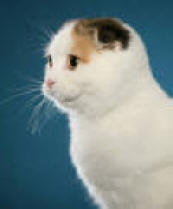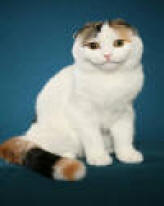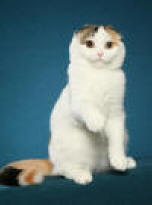|
Departments
eBook now Available!
|
Exclusive - THE book on Traditional & Classic
Siamese cats
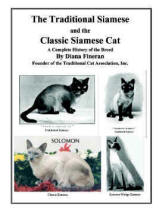
Written by the Founder of TCA, Inc.
Tullycrine
Affordable
Web Design
|
|
|
TRADITIONAL SCOTTISH FOLD©® CAT FAQs (TSF)
Breeders of the Traditional
Scottish Fold
HISTORY - PERSONALITY -HEALTH
Copyright ©
Trademark ®, Diana Fineran, January 2, 2007
Photos Courtesy of Susan Williams - Copyright Helmi
Flick (Click Photos to Enlarge)
HISTORY
Mother Nature created a spontaneous mutation in farm cats
in
Scotland
resulting in the Traditional Scottish Fold.
The breed was established by using crosses to British Shorthair and
domestic cats in Scotland
and England.
The out cross breeds in America are the Traditional American Shorthair, the
Traditional American Long hair, the Traditional British Shorthair, a Persian or
two and a Burmese.
Historically there have been prior sightings of folded
eared cats. An antique Oriental wall
hanging showing a folded eared white cat and her white kittens recently sold.
Further reference was made in, “The 1975 Guide to the Cats of the World”,
by Loxton, “The idea of a drop-eared Chinese breed was a persistent one.” The
first known acknowledgement of this type of cat appeared in 1796 in the
“Universal Magazine of Knowledge”, where they were mentioned as wild cats in
China.
The “guide to the Cats of the World” continued, “A century late a sailor
returned from China with a drop-eared cat.” No more documented evidence appeared
until 1938 when a second drop eared cat was found.
With limited genetic knowledge about the mutation at that time, it was
believed the drop ear characteristic was limited only to white long haired cats,
which was the coloration of all of the prior cats.
Susie, a white barn cat, was the very first recognized and
documented Traditional Scottish Fold, who all modern day, bona fide “Folds”
trace their parentage to. The striking thing about Susie was her ears were
folded downward and forward! She is the
first folded eared cat discovered by William and Mary Ross, who were British
Shorthair breeders, and the founders of the Traditional Scottish Fold breed. In
1961 William Ross, a shepherd, noticed Susie at the McRae farm, near Coupar
Angus in the Tayside Region of Scotland,
Northwest or Dundee.
The Ross’s were told by the McRae’s that
Susie’s mother had straight ears, but nothing was known about her father. One
year later Susie gave birth to two folded kittens, sired by a local tom and both
had folded ears. The male was given
away. The Ross’s asked for one of Susie’s kittens and were given the folded ear,
white, female in 1963, named her,
Snooks, and went on to develop the breed from her.
Three months later Susie was killed by a
car on the road in front of her home.
Snooks was bred to a red tabby male of unknown breeding.
A male kitten named, “Snowball” came from her first litter and was
subsequently bred to a white British Shorthair, “Lady May”.
Their litter produced five folded kittens.
In 1969 Snooks had her third litter of two folded kittens: Denisla
Hester and Denisla Hector. Along with “Snowball” and “Lady May’s” kittens, the
lineage expanded. Since the Den and Isla rivers flowed near their cottage, the
Ross’s used a combination of the two rivers and named their cattery “Denisla.
The newness of the breed brought the Ross’s to Pat Turner and the English
geneticist, Pater Dyte, for help in progressing the breed through out crossing
to British Shorthairs and domestic farm cats. “The Ross’s wrote to me in 1967,”
Turner recalled, “At that stage they still referred to their cats as “lop
eared”, after the lop eared rabbits.” Through this experiment Pat Turner
produced seventy six kittens: forty
two with folded ears and thirty four with straight ears. Pat Turner began
showing her “folds”. Originally call “Lops”, after the lop eared rabbits, the
breed name became known as Scottish Folds in 1966.
Breeding continued in Europe to preserve
the rare mutation.
Little was known about the natural mutation that causes the
folded ear. Early in the 1970’s and
English geneticist, Dr. Oliphant Jackson released a report stating the breed
carried a bone problem, that no previous mention of associated skeletal
deformity appeared before the 1970’s, and vital use of out crosses were needed
to restore the original health of the breed!
X-rays of “Folds” started showing bone lesions at that time.
Questions arose about whether this was caused by early in-breeding or
with the “fold” gene itself.
Photos Courtesy of Susan Williams - Copyright Helmi
Flick
(Click Photos to Enlarge)
In addition to these problems, many “Folds” originally had
shortened tails that were inflexible. Help was sought from Dr. Rosemond Peltz,
who offered, “in generations to come the undesirable defect may be diminished by
extremely careful breeding.” More
out crossing was used and the gene pool enlarged.
Longer more flexible tails began to be produces and the shorten tails and
bone lesions began to disappear. Out
crossing remains a fundamental part of Traditional Scottish Fold breeding
programs today. The stiff tail is eliminated by breeding a folded ear to a
straight ear or an allowed out cross breed.
Due to mostly erroneous and unfounded allegations of
possible increase in ear mite infestation, deafness and possible genetic
difficulties, and due to the opposition from British Shorthair breeders who
opposed the use of their breed, the
British, Governing Council of the Cat Fancy (GCCF) closed and banned the
Registration of any Traditional Scottish Folds in 1971!
Denisla Morag was the last Traditional Scottish Fold to be registered
with the GCCF! Mary Ross stated only one other cat lover besides herself were
left breeding them in England at that time!
No longer supported in their home country, except by a few
loyal breeders, the Traditional Scottish Fold came to America in 1970 as research subjects for Dr. Neil
Todd, a New England geneticist.
At the Carnivore Genetics Research Center in Newtownville, MA.
Dr. Todd brought “Denisla Judy”, “Denisla Joey” and “Denisal Hester”, who were
three daughters of Snooks. Dr. Todd’s purpose was to gather a colony of cats for
“scientific inspection of mutations”.
None of his cats were ever intended to be part of the cat fancy.
Under his watch full eye Joey and Judy produced two litters. Shortly
there after, Dr. Todd lost interest,
ended his research project and discipated his cats to various homes.
Lynn Lamoreux, a doctoral student of Dr. Todd’s, gave “Hester” to Salle
Wolf Peter, a Manx breeder in south eastern Pennsylvania. . One of “Hester’s” kittens
went to an English couple in Utah
in 1972. It was in Utah
where the female, “Martina Shona”, owned by Briony Sivewright, was first shown.
Early breeders involved with furthering the breed in the U.S.
were: Ann Kimball, Bobbie Graham, Salle Wolf Peters, Jean Grimm, Lois & Clark
Jensen, Pat Dreifuss, Shirley Norquist, Gay Turner, Nancy Aabbott, Bill and
Patti Brubaker, Mary Auth, Chuck Payne, Donna Jean Thompson, Sue and Bruce
Thompson, Junerose Wilkerson, Sharon Knight, Ken Burke, Kitty Angell and Karen
Votava. “Mr Morgan LeFaye” a Cameo,
Tabby Male, was acquired by Karen Votava.
Together with “Doonie Lugs, “Mr Morgan LeFaye” became the foundation
stock for Bryric Cattery.
Famous cat names in Traditional Scottish Fold pedigrees
are; “Jensen Minnie Pearl”, “Bryric
Fanny Folderol of Kitjim”, “Bryric Patchwork”, “NW Kitjim’s Briarpatch”, “B4
Snow B-Ear-Y of Sweetums”, “Kitjim’s
Buckwheat of Sweetums”, “RW Beebop Duke of Earle of Beepafold”, “NW Kitjim’s
Bonny Too of Q-T cats” and, “Norton”.
The Traditional
Scottish Fold comes in both folded ears and straight ears and short and long
hair. The use of Persians in early
breedings helped establish the long hair gene. An incomplete dominant gene
produces the folded ear. That means if a kitten inherits one gene for folded
ears and one gene for straight ears, it most likely will develop folded ears.
Also, if a heterozygous “Fold”, which carries a fold eared gene and a straight
eared gene is bred to a straight eared cat about 50% or their kittens will
develop folded ears. That ratio is
said to increase to 75% if both parents are heterozygous ‘folds”. About one
third of the kittens from genetically “Fold” to “Fold” breedings may develop
skeletal lesions in the tail and hindquarters.
Both folded and straight eared cats are used in breeding programs as
invaluable bloodlines to further the breed.
Since one of a breeding pair must have straight ears, the chances of
producing a folded ear kitten in a litter are about 50% over a period of time.
Not every litter will produce 50% folded kittens. A mixture of all
straight ears, only one kitten with folded ears, etc. is the norm. Therefore, it
takes great patience on the part of breeders who are involved with this breed.
Despite being folded their ears are still expressive.
Their can swivel to listen, lay back in anger and perk up when something
interesting draws their attention.
The fold in the ear can become less pronounced in illness, heat or distress.
Kittens are born with straight ears that either fold or not
by four weeks of age. All colors are
accepted as well, so there is an infinite variety. Their cute appearance will
win any heart.
Photos Courtesy of Susan Williams - Copyright Helmi
Flick
(Click Photos to Enlarge)
PERSONALITY
Their winsome, loving, intelligent disposition matches
their sweet, open, hear-no-evil expression.
With tiny voices, they are not extremely vocal.
Human companionship is completely adored by them and they display this
need in their own quiet way. Placid and calm “Folds” love to sit in your lap,
cuddle with you in your bed, run to the door to greet you and are not finicky
eaters. Sweet Tempered, devoted but not demanding, bouncy on occasion, but never
boisterous, more likely to charm than to challenge they quickly endear
themselves to your heart. They
easily adapt to nearly all home situations from a single room to a large house,
from a room full of children and dogs to a single person’s home.
They adjust to other animals extremely well.
Provided with great nutrition, a clean environment, lots of toys and
generous amounts of love and attention they thrive.
This breed is for those who love their gentle, open eyed look, sweet
disposition and gentle calm nature.
HEALTH
The Traditional Scottish Fold is a sturdy, hardy cat, true
to their barn cat heritage. They lead long, healthy lives, often up to or past
age 19. There is an unfounded misconception that they become crippled as they
age. This, of coarse, is untrue!
The long hair variety has a surprisingly easy care coat.
A good combing once a week will suffice for most. Their hair lacks the
downy under coat and doesn’t matt like a Persian’s will.
The Traditional Scottish Fold gene can cause thickening and
crippling of the joints, particularly in homozygous “Folds”,(kittens who inherit
two fold eared genes). This is called congenital osteodystrophy, a genetic
condition that causes crippling distortion and enlargement of the bones. These
anomalies are not life threatening, nor is the fold ear gene a lethal one.
Careful breeding practices, avoiding “fold” to “Fold” breeding, reduces
the problem.
Top
|
|
|
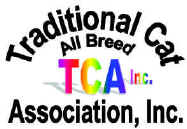
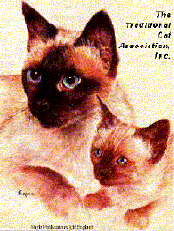 The
Traditional Cat Association,
Inc.©1987®TM
Official Website
The
Traditional Cat Association,
Inc.©1987®TM
Official Website
